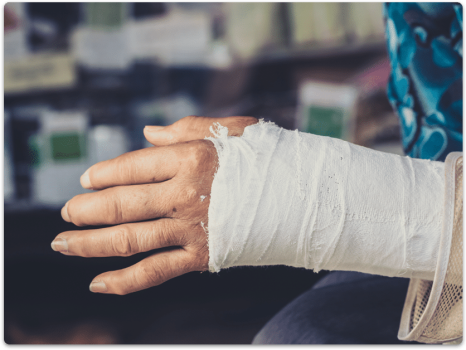Burn Injuries in Nursing Homes
Burn injuries are a common occurrence in nursing homes, with elderly residents being at higher risk due to factors such as decreased mobility, sensory deficits and cognitive impairment. Burn injuries can be caused by hot surfaces, scalding liquids, and flames, and are often preventable with proper staff training and safety protocols. prompt treatment is essential in reducing the severity of the injuries and preventing complications such as infections.

What are the most common causes of burns in nursing homes?
Burns in nursing homes are almost always the result of some level of abuse or neglect by nursing home staff.
Scalds
Scalds are burns caused by hot liquids. As noted by the State of Michigan Department of Community Health, the following factors make elderly individuals more vulnerable to scalds:
- Impaired sensation that prevents elders from reacting quickly to heat
- Slower reaction time in general
- Thinner skin, which burns to its full depth more readily
Nursing home residents could come into contact with hot liquids if the nursing home fails to take protective measures. Liquids at temperatures of 120 degrees can cause deep and severe burns in minutes, while hotter temperatures can do so in seconds.
Coffee and Food
Hot coffee and the steam from hot foods can cause painful and severe burns. Health conditions common to the elderly, such as arthritis, neuropathy and Parkinson’s disease, can increase the risk of elders spilling coffee on themselves. Nursing homes should always ensure food and coffee are served at safe temperatures, and that coffee is served in cups with secured lids.
Baths and Showers
Nursing homes must ensure water heater settings are at safe levels. The Centers for Medicaid and Medicare Services do not provide guidelines, but the state of Michigan requires nursing homes to maintain water heater settings between 105 and 120.
Unsupervised Smoking
The 2017 tragic death of 83-year-old Donna Chapman in a St. Louis nursing home, as reported by the St. Louis Post-Dispatch, serves as a grim reminder of the importance of proper supervision. Ms. Chapman was a wheelchair-bound patient who was partially paralyzed by a stroke she had suffered years prior.
The nursing home staff left her alone to smoke on the patio for 10 minutes by their account, only to find her engulfed in flames upon their return. She suffered third-degree burns to 20 percent of her body and died two days later. Her family was devastated. The incident raised the following questions by the family:
- Was she really only left unsupervised for 10 minutes?
- Why was she not wearing the fire-resistant smoking apron that had been assigned to her months prior?
- Were staff properly trained to use the fireproof blanket to smother the flames?
Many nursing homes prohibit smoking altogether. Those that allow smoking must take proactive measures to ensure residents do not burn themselves in the process.
Accidental Fires
Nursing homes should have a plan to quickly evacuate residents, including those with mobility issues, in a fire emergency. The NFPA has provided a list of criteria families should use when selecting a nursing home to ensure it is prepared for emergencies.
- Fire-safe building maintenance: no paper or other clutter blocking doors or hallways
- An evacuation plan involving staff and residents with regular drills
- Fire-safe building systems, such as smoke detectors, fire sprinklers and fire exits
- Adequate staff-to-patient ratios at all times, including during night and weekend shifts
- Safe smoking guidelines and supervision
- Willingness to answer questions about safety measures
Physical Abuse
Unexplained burns on your family member could be a warning sign of physical abuse, according to the National Council on Aging. This can include scalds, friction burns from restraints or cigarette burns. According to Access Medicine, burns that are “bilateral and uniform” are especially suspicious.
Types of Burns
Burns are categorized according to their depth. The National Institute of General Medical Sciences classifies burns as follows:
- First-Degree Burns – Burns affecting only the outer layer of the skin
- Second-Degree Burns – Burns that affect both layers of the skin, which may require skin grafting
- Third-Degree Burns – Burns that destroy both layers of the skin and reach underlying tissues, which always need skin grafts
- Fourth-Degree Burns – Burns that extend into the fatty tissues
- Fifth-Degree Burns – Burns that reach the muscle
- Sixth-Degree Burns – Burns that reach the bone
Burn Injury Complications in the Elderly
According to UpToDate, older adults with the following characteristics face the highest risks of experiencing burns:
- Smokers
- Limited mobility
- Slow reaction times
- Sensory impairment
- Decreased coordination
- Medication side effects
- Cognitive decline
Elderly burn patients are also more likely to suffer secondary complications within days of the original injury, including:
- The need for excision and grafting
- Infections
- Sepsis
- Shock
- Multi-organ failure
- Death
Are nursing homes always liable for patients’ burn injuries?
When nursing homes accept patients, they accept responsibility for any harm that comes to patients while under their care. A nursing home has the duty to provide a safe, hospitable environment for residents. Their duties include but are not limited to the following:
- Protect patients
- Supervise patients
- Take proactive measures to prevent injuries
- Plan and prepare for emergencies
- Maintain their facilities
- Comply with federal, state and local building codes
- Provide quality medical care
- Report abuse
- Properly screen and train staff
Nursing homes are liable for any actions or lack thereof by staff, administrators or other residents that harm residents.
Compensation for Nursing Home Burn Injuries
If your loved one experiences harm or wrongful death while under the care of a nursing home, you and your loved one may be able to claim compensation for the following:
- Medical expenses
- The cost of moving your loved one to a safer facility
- Lost wages
- Pain and suffering
- Burial expenses
- Funeral expenses
What should I do if I observe burn injuries on my family member who resides in a nursing home?
If you observe nursing home injuries on your loved one that appear to be burns, it is important to act quickly to protect your family member.
- If your family member is cognizant, ask him or her about the circumstances surrounding the injuries.
- If your loved one seems uncomfortable answering you, it could confirm abuse is occurring.
- Report the abuse to the long-term care ombudsman or adult protective services.
- Contact law enforcement.
- Contact the doctor.
If you are unable to identify the staff member responsible for the abuse, or if the nursing home seems complacent or retaliatory about the allegation, you may need to consider moving your loved one to another facility while you continue the process of holding the nursing home accountable.
You may be able to file a civil lawsuit against the nursing home. This can be a complex process. Our legal team can help you explore your options. If you or your loved one has been harmed by a nursing home, contact us today for a free consultation.
- Last Modified April 30, 2023
- Editorial Guidelines
Dr. Patricia Shelton, MD

Education:
- University of Washington, Doctor of Medicine – MD. June 2008
- University of Washington, Bachelor of Science – BS, Jun 2003
Background:
Neuroscience and Medicine
Career:
- Dr. Shelton primarily writes content for health-related websites, but has also written test prep materials, white papers, published research articles, court documents, and more.
- Dr. Shelton teaches anatomy and physiology at the college level for the National Institutes of Health.
